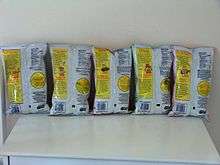Hostess Potato Chips


Hostess Potato Chips was the leading potato chip brand in Canada for many years. They fended off any attempt to displace them from their commanding position, and retained their #1 position into the 1980s, even in the face of increased competition from US-based companies entering the Canadian market. They eventually suffered serious brand erosion in the early 1990s with the introduction of various "upscale" brands such as Kettle Chips and Miss Vickie's. The brand was replaced by Lay's in 1996 as part of its major re-branding exercise. As of 2015, the Hostess brand is used only on a few products.
History
Beginnings
Hostess was formed in 1935 when Edward Snyder began cooking chips on his mother's kitchen stove in Breslau, outside Kitchener, Ontario. Potato chips remained a fairly small part of the snack food market until the 1950s, when snack foods in general became more widely available. In 1955, Snyder sold his company to E.W. Vanstone, who expanded the company greatly before selling his interest to General Foods in 1959.[1]
Hostess grew to become the #1 brand through this period and into the 1980s. Their powerful distribution channels made competing on price difficult, and shelf space for competing products was difficult to find, notably in smaller stores such as gas stations. The brand also gained a strong reputation for quality at the expense of other brands. Their packaging was instantly recognisable, featuring simple graphics and colour schemes. For much of the brand's history, only three flavours were sold; Regular in a blue package, Salt and Vinegar in yellow, and BBQ in deep red. The power of the brand was such that competitors generally used the same colours on their packaging as well, creating a standard of sorts.
In the mid-1970s, Hostess decided to expand its lineup and introduced three new flavours, Orange, Cherry and Grape. The attempt was a dismal failure, and the products disappeared from stores only a few months later. The products were so poorly received they remain a topic of derision to this day. Newer introductions followed, starting with the popular Sour Cream and Onion shortly after the fruit flavours disappeared. This was a huge success, and was followed by a series of other now-common flavours such as Dill Pickle and Ketchup. Another success was Hickory Sticks, a hickory-smoke-flavoured chip which broke the corporate branding by using a wood-grain patterning on their smaller bags.
Starting in 1981, the chips had new mascots known as the Munchies, that were used for advertisements and appeared on the chip packaging. The Munchies were three friendly goblin-type creatures coloured red, orange, and yellow.
New chapter
The introduction of corn chips to the market led to a partnership between Hostess and Frito-Lay (owned by PepsiCo) in 1987, bringing Doritos to Canada for the first time. This was followed by the introduction of other Frito Lay brands, including Ruffles, Tostitos and Cheetos (Lay's, Frito Lay's major US chip brand, was already being licensed for Canadian manufacture by another company). Hostess remained the major chip brand even after the arrangement. The partnership led to a merger in 1988, with the joint company known as Hostess Frito Lay. In 1992 PepsiCo acquired full ownership of the company by buying out General Foods' remaining interest.[2]
Through the 1990s a number of "boutique" brands introduced a wide variety of new chip flavours, a pattern that Hostess did not follow. Its brand value was enormously eroded, and they became known as a low-end brand in the same fashion that former Hostess competitors found themselves pushed into for many years. They retained their #1 position, but slipped in sales terms to holding about 10% of the market by the mid-1990s.
Former Hostess products were replaced or rebranded after the merger; Hostess Taquitos became Zesty Doritos; Cheddar and "nacho"-flavoured Crunchits were supplanted by corresponding flavours of Crunchy Cheetos (BBQ Crunchits had long been out of production).
Decline
With the brand popularity falling, in 1996 it was decided to re-brand the product as Lay's. This presented no small amount of difficulty; the product was already on sale in Canada via a third party, and was considered even "lower end" than Hostess. An aggressive advertising campaign by BBDO Canada featuring famous hockey players such as Mark Messier and Eric Lindros launched the "new" brand in 1997, and within eighteen months Lay's was selling twice as much product as it had been with the Hostess name.[3] Hostess has largely disappeared, and recently the company dropped "Hostess" from its name, becoming Frito Lay Canada.
The only remaining major Hostess retail product is Hickory Sticks, which is still found in most stores across Canada. However, in order to maintain its trademark protection on the Hostess brand, Frito Lay continues to sell Hostess-branded potato chips in some lower-end grocery stores, such as Food Basics, FreshCo and Price Chopper, albeit limited to its early 1990s lineup of flavours.
Hostess is so undervalued by parent corporation PepsiCo Canada, that it does not merit a category on the website snack brands list. However, Hostess Hickory Sticks is listed under "Other Brands.
Marketing
During its existence, the slogan for Hostess chips was "'Cause when you've got the munchies, nothing else will do. Hostess Potato Chips!"[4][5][6]
References
- ↑ PepsiCo Foods Canada web site
- ↑ http://www.nytimes.com/1992/06/26/business/company-news-hostess-frito-lay-is-acquired-by-pepsico-foods.html
- ↑ Lay's Potato Chips
- ↑ In The 80s - Favorite Commercials From Television and Radio in the Eighties, Products Beginning with H
- ↑ Logo Design by VivaLogo / Logo Library / List of advertising slogans
- ↑ Hostess Munchies 1991 Commercial